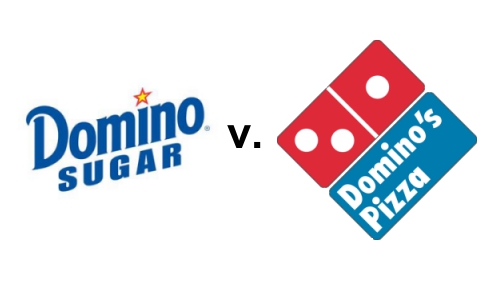 Domino is a trademark for and a brand of sugar. Sugar is a type of food. Domino’s Pizza is a trademark for a pizza restaurant chain. Pizza is a food.
Domino is a trademark for and a brand of sugar. Sugar is a type of food. Domino’s Pizza is a trademark for a pizza restaurant chain. Pizza is a food.
Amstar, which owned the Domino sugar brand at the time, sued Domino’s Pizza alleging trademark infringement over the use of the term Dominos. But Amstar lost.
Why? Similarity of the marks and similarity of the goods is usually a good start to making a strong case of trademark infringement. Here, there was a similarity between the marks, e.g. “Domino.” And, there was arguably similarity between the goods, i.e. food.
Yet, Amster lost because, in part, the Domino mark was weak in relation to food generally.
Many Third-Party Uses for Similar Goods: Weak Trademark Rights
Why was the “Domino” mark weak? It was weak because many other companies used Domino on other types of food.
I previously discuss factors to consider for selecting a strong trademark. Another factor in trademark strength is whether many others are using the same or similar mark in the marketplace for the same or similar goods or services. When many third parties are using the mark on similar goods, that mark will be considered a weak mark. Weak marks are provided a narrow scope of protection.
In the case of Amstar Corp. v. Domino’s Pizza, Inc., 615 F.2d 252, 259 (5th Cir. 1980), Domino’s Pizza showed that there were 72 other trademark registrations of the term “Domino” at the U.S. Patent and Trademark Office. Some of those registrations involved foods, such as canned fruits, cheese, wheat flour, canned sardines, and candy. Domino’s Pizza also introduced evidence of 15 uses of marks that included “Dominos” in the marketplace by other companies, including uses related to food and grocery stores.
The court noted that “The greater the number of identical or more or less similar trade-marks already in use on different kinds of goods, the less is the likelihood of confusion….” The court also stated, “The third-party uses and registrations discussed above merely limit the protection to be accorded plaintiff’s mark outside the uses [sugar] to which plaintiff has already put its mark.”
Therefore Amstar’s trademark rights to Domino did not extend to any food but was confined to sugars. The court concluded limited strength and protection outside of its sugar goods was an important factor in determining that Domino’s Pizza’s use of the term “Domino” did not constitute trademark infringement.
Responding to Trademark Cease and Desist: Search for Third Party Uses
Therefore, when you are on the receiving side of a trademark cease and desist letter, you should be searching to see if there are other similar registered marks used for similar goods. You can do that by searching the USPTO trademark database. You should also search for third party uses in the marketplace of the same or similar marks for the same or similar goods. You can do that by any method of searching the market, e.g. search the internet.
The more third party uses the better. But, you don’t need to find 72 registrations, even a handful can be effective depending on the circumstance.
Finding that multiple third parties have registrations or uses in the marketplace for the same or similar mark with the same or similar goods, may be a basis to assert that the plaintiff’s trademark rights are weak. If the trademark rights are weak, it may be that the differences in the goods/services are sufficient to conclude there is no trademark infringement, as was the case for Domino’s Pizza.
See the prior posts in this series: